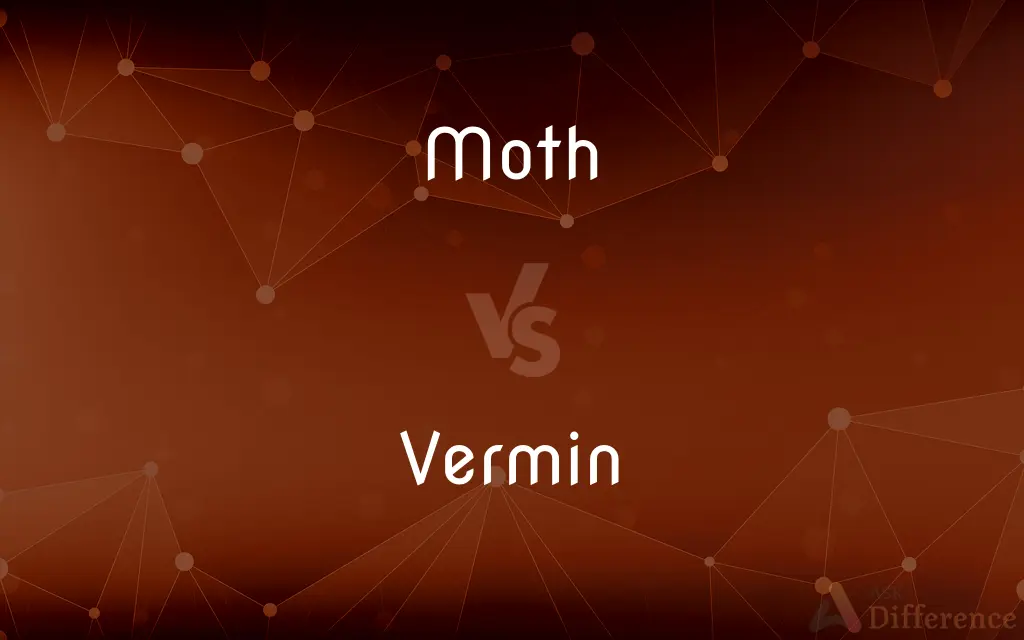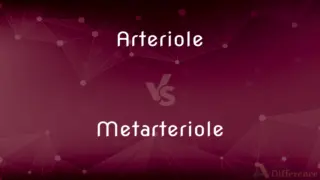Moth vs. Vermin — What's the Difference?
By Urooj Arif & Maham Liaqat — Updated on April 8, 2024
Moths are winged insects related to butterflies, while vermin refers broadly to pests or nuisance animals.

Difference Between Moth and Vermin
Table of Contents
ADVERTISEMENT
Key Differences
Moths belong to the order Lepidoptera, sharing many similarities with butterflies, including having wings covered with scales. They are known for their nocturnal habits and, in some cases, their larvae (caterpillars) can cause damage to crops and fabrics. Moths are diverse, with thousands of species varying in size, color, and habitat. On the other hand, vermin is a term that encompasses various pests or nuisance animals that are considered harmful to health, property, or society. This term can include insects like cockroaches and bedbugs, rodents like rats and mice, and other animals deemed pests.
While moths can be considered vermin when their larvae damage clothing, crops, or stored products, the term vermin has a broader application. It is used to describe any animal or insect that negatively impacts human activities or well-being. Moths, when not causing harm, are generally not referred to as vermin, highlighting the situational use of the term based on the context of the moth's impact on human interests.
The distinction between moths and vermin is significant in discussions of pest control, biodiversity, and environmental health. Moths, as specific creatures, contribute to their ecosystems, for instance, by pollinating plants or serving as food for other animals. Conversely, the term vermin is used in a negative context, focusing on the need to control or eradicate the animals or insects classified under this term to protect human health, food, and living conditions.
Understanding the role of moths in the environment helps differentiate them from the broader, often pejorative, concept of vermin. While some moth species are pests, many play crucial roles in their ecosystems. The term vermin, however, inherently carries negative connotations, emphasizing the perceived threat or nuisance of the animals it describes to human interests.
The key difference lies in the specific nature of moths as insects within a biological classification, contrasted with the generic, negative label of vermin applied to various pests. This distinction is essential for accurate communication in science, pest management, and public health.
ADVERTISEMENT
Comparison Chart
Definition
Winged insects related to butterflies
Pests or nuisance animals
Context
Specific species within Lepidoptera
Broad category encompassing many pests
Impact
Can be pests but also play ecological roles
Generally considered harmful to human interests
Classification
Biological, within a specific order
Descriptive, based on impact rather than taxonomy
Perception
Varied, can be positive or negative
Predominantly negative
Compare with Definitions
Moth
Some species are pests, damaging clothes and crops.
The pantry was infested with moths that ruined the stored grains.
Vermin
Includes species harmful to agriculture.
Farmers often take measures to protect crops from vermin.
Moth
An insect related to butterflies, active mainly at night.
The silk moth is known for producing silk during its larval stage.
Vermin
Animals or insects considered pests.
Rats, commonly viewed as vermin, can spread diseases.
Moth
Plays roles in ecosystems, such as pollination.
The hummingbird moth is crucial for the pollination of certain night-blooming flowers.
Vermin
Can carry diseases affecting humans.
Public health campaigns aim to control vermin to prevent the spread of illness.
Moth
Diverse, with thousands of species worldwide.
The atlas moth, one of the largest in the world, boasts impressive wingspans.
Vermin
Broad term with negative connotations.
The city implemented pest control programs to manage the vermin population.
Moth
Known for their scaly wings.
Attracted to the light, the moth fluttered around the lamp.
Vermin
Often associated with causing damage to properties.
The old house was infested with vermin, from mice to cockroaches.
Moth
Moths are a paraphyletic group of insects that includes all members of the order Lepidoptera that are not butterflies, with moths making up the vast majority of the order. There are thought to be approximately 160,000 species of moth, many of which have yet to be described.
Vermin
Vermin (colloquially varmint(s) or varmit(s)) are pests or nuisance animals that spread diseases or destroy crops or livestock. Since the term is defined in relation to human activities, which species are included vary by region and enterprise.
Moth
Any of numerous insects of the order Lepidoptera, generally distinguished from butterflies by their nocturnal activity, hairlike or feathery antennae, stout bodies, and the frenulum that holds the front and back wings together.
Vermin
Wild animals that are believed to be harmful to crops, farm animals, or game, or which carry disease, e.g. rodents
Killed as vermin or game, the pumas have gone
Moth
A clothes moth.
Vermin
Any one of various common types of small insects or animals which cause harm and annoyance.
The area was plagued by all sorts of vermin: fleas, lice, mice, and rats to name a few.
Moth
A usually nocturnal insect of the order Lepidoptera, distinguished from butterflies by feather-like antennae.
Vermin
Animals that prey on game, such as foxes or weasels.
Moth
(figurative) Anything that gradually and silently eats, consumes, or wastes any other thing.
Vermin
Obnoxious, or mean and offensive person or people.
Bring these vermin to the Palace of Justice.
Moth
The plant Vigna aconitifolia, moth bean.
Vermin
An animal, in general.
Wherein were all manner of fourfooted beasts of the earth, and vermin, and worms, and fowls.
This crocodile is a mischievous fourfooted beast, a dangerous vermin, used to both elements.
Moth
(intransitive) To hunt for moths.
Vermin
A noxious or mischievous animal; especially, noxious little animals or insects, collectively, as squirrels, rats, mice, worms, flies, lice, bugs, etc.
Great injuries these vermin, mice and rats, do in the field.
They disdain such vermin when the mighty boar of the forest . . . is before them.
Moth
A mote.
Vermin
Hence, in contempt, noxious human beings.
You are my prisoners, base vermin.
Moth
Any nocturnal lepidopterous insect, or any not included among the butterflies; as, the luna moth; Io moth; hawk moth.
Vermin
An irritating or obnoxious person
Moth
Any lepidopterous insect that feeds upon garments, grain, etc.; as, the clothes moth; grain moth; bee moth. See these terms under Clothes, Grain, etc.
Vermin
Any of various small animals or insects that are pests; e.g. cockroaches or rats
Moth
Any one of various other insects that destroy woolen and fur goods, etc., esp. the larvæ of several species of beetles of the genera Dermestes and Anthrenus. Carpet moths are often the larvæ of Anthrenus. See Carpet beetle, under Carpet, Dermestes, Anthrenus.
Moth
Anything which gradually and silently eats, consumes, or wastes any other thing.
Moth
Typically crepuscular or nocturnal insect having a stout body and feathery or hairlike antennae
Common Curiosities
What defines an animal as vermin?
An animal is defined as vermin if it is considered a pest or nuisance, especially those harmful to human health, agriculture, or property.
What is the difference between pests and vermin?
The terms are often used interchangeably, but "vermin" typically carries a stronger negative connotation, often referring to animals seen as particularly vile or disease-ridden.
Can moths be considered vermin?
Yes, moths can be considered vermin when their larvae damage clothing, crops, or stored products, making them pests in those contexts.
Can the classification of vermin change over time?
Yes, the classification of what constitutes vermin can change based on shifts in human attitudes, environmental conditions, and the balance of ecosystems.
What ecological roles do moths play?
Moths contribute to ecosystems through pollination, serving as food for other species, and participating in the nutrient cycle.
How do humans typically control vermin populations?
Humans control vermin through various methods, including traps, poisons, biological control agents, and public health policies aimed at reducing habitats or food sources.
Do all cultures classify the same animals as vermin?
No, cultural differences and environmental factors lead to variations in which animals are classified as vermin around the world.
Are all moths harmful?
No, not all moths are harmful; many play important ecological roles, such as pollination or serving as food for other species.
Why are some animals classified as vermin?
Animals are classified as vermin due to their perceived negative impact on human activities, health, or property.
Is it possible to have a positive perspective on vermin?
Perspectives on vermin can be positive when considering the ecological roles and biodiversity they contribute to, though this is less common due to the focus on their negative impacts.
How do cultural perceptions of vermin vary?
Cultural perceptions of what constitutes vermin can vary widely, influenced by local ecosystems, economic activities, and historical context.
What are the consequences of vermin infestation?
Consequences include damage to property and crops, spread of diseases, and general nuisance, impacting economic and health conditions.
How does urbanization affect vermin populations?
Urbanization can increase vermin populations by providing more shelter, food sources, and nesting sites, often leading to greater efforts at pest control.
Why is it important to control vermin populations?
Controlling vermin is crucial for protecting human health, preserving food supplies, maintaining property, and preventing economic losses.
What measures are taken in agriculture to control moths?
Measures include the use of pesticides, biological control agents like parasitic wasps, and cultural practices like crop rotation to manage moth populations.
Share Your Discovery

Previous Comparison
Arteriole vs. Metarteriole
Next Comparison
Faster vs. QuickerAuthor Spotlight
Written by
Urooj ArifUrooj is a skilled content writer at Ask Difference, known for her exceptional ability to simplify complex topics into engaging and informative content. With a passion for research and a flair for clear, concise writing, she consistently delivers articles that resonate with our diverse audience.
Co-written by
Maham Liaqat













































